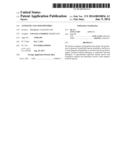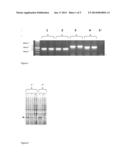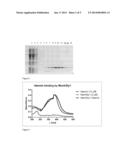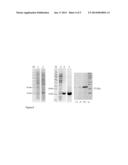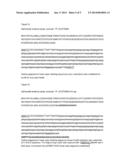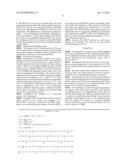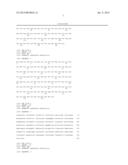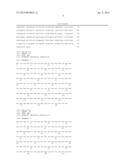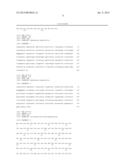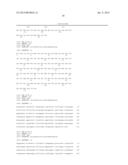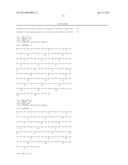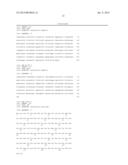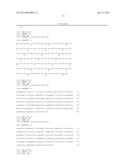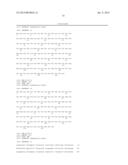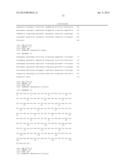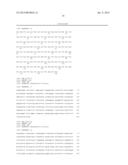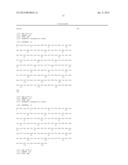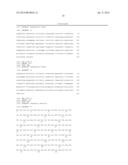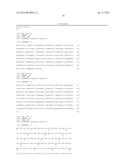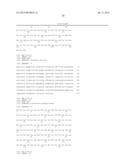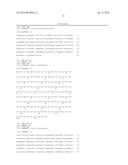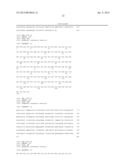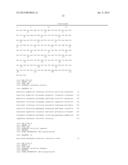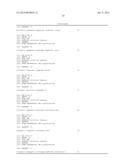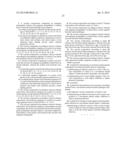Patent application title: ANTIGENIC GLY1 POLYPEPTIDES
Inventors:
Jon Sayers (Chesterfield, GB)
Jon Sayers (Chesterfield, GB)
Assignees:
UNIVERSITY OF SHEFFIELD
IPC8 Class: AC07K14285FI
USPC Class:
4241901
Class name: Antigen, epitope, or other immunospecific immunoeffector (e.g., immunospecific vaccine, immunospecific stimulator of cell-mediated immunity, immunospecific tolerogen, immunospecific immunosuppressor, etc.) amino acid sequence disclosed in whole or in part; or conjugate, complex, or fusion protein or fusion polypeptide including the same disclosed amino acid sequence derived from bacterium (e.g., mycoplasma, anaplasma, etc.)
Publication date: 2014-01-09
Patent application number: 20140010836
Abstract:
We disclose antigenic polypeptides that induce the production of
opsonins, in particular opsonic antibodies, and the use of said antigenic
polypeptides in vaccines that are protective against bacterial animal
pathogens in particular bacterial pathogens of agriculturally important
animal species and companion animals and including zoonotic Gram negative
bacterial species.Claims:
1. A vaccine composition comprising an antigenic polypeptide wherein said
antigenic polypeptide is isolated from a bacterial animal pathogen and
comprises: i) an amino acid sequence selected from the group consisting
of: SEQ ID NO: 1, 2, 5, 6, 9, 10, 13, 14, 17, 18, 21, 22, 25, 26, 29, 30,
33, 38, and 40; or ii) an amino acid sequence as defined in i) above and
which is modified by addition, deletion or substitution of one or more
amino acid residues and which retains or has enhanced haem binding
activity and/or reduced haemolytic activity.
2. The vaccine composition according to claim 1, wherein said antigenic polypeptide comprises or consists of an amino acid sequence as represented in SEQ ID NO: 1, 2, 5, 6, 9, 10, 13, 14, 17, 18, 21, 22, 25, 26, 29, 30, 33, 38 or 40.
3. The vaccine composition according to claim 1 wherein said antigenic polypeptide comprises or consists of an amino acid sequence shown in SEQ ID NO: 1, 2, 5 or 6.
4. A vaccine composition comprising a nucleic acid molecule that encodes an antigenic polypeptide isolated from an animal pathogen, wherein the nucleic acid molecule comprises: i) a nucleotide sequence selected from the group consisting of: SEQ ID NO: 3, 4, 7, 8, 11, 12, 15, 16, 19, 20, 23, 24, 27, 28, 31, 32, 34, 39, and 41; ii) a nucleotide sequence degenerate as a result of the genetic code to the nucleotide sequence defined in (i); or iii) a complementary strand to the nucleotide sequence in i) or ii) and which hybridizes under stringent hybridization conditions to the nucleotide sequence in i) and ii) above wherein said nucleic acid molecule encodes a haem binding protein.
5. The vaccine composition according to claim 4, wherein said nucleic acid molecule comprises or consists of a nucleotide sequence as represented in SEQ ID NO: 3, 4, 7, 8, 11, 12, 15, 16, 19, 20, 23, 24, 27, 28, 31, 32, 34, 39 or 41.
6. The vaccine composition according to claim 4, wherein said nucleic acid molecule comprises or consists of a nucleotide sequence shown in SEQ ID NO: 3, 4, 7 or 8.
7. The vaccine composition according to claim 4, wherein said nucleic acid molecule comprises a transcription cassette comprising: the nucleic acid molecule that encodes said antigenic polypeptide operably linked to a promoter adapted for transcription of the nucleic acid molecule that encodes said antigenic polypeptide.
8. The vaccine composition according to claim 7, wherein said nucleic acid molecule is part of a vector.
9. The vaccine composition according to claim 1, wherein said antigenic polypeptide is isolated from a Gram negative bacterial animal pathogen.
10. The vaccine composition according to claim 9, wherein said antigenic polypeptide is isolated from a Gram negative zoonotic bacterial animal pathogen.
11. The vaccine composition according to claim 10 wherein said bacterial animal pathogen is selected from the genus group consisting of: Mannheimia spp, Actinobacillus spp, Pasteurella spp, Haemophilus spp and Edwardsiella spp.
12. The vaccine composition according to claim 10, wherein said bacterial animal pathogen is selected from the group consisting of: Brucella spp, Campylobacter spp, Vibrio spp, Yersina spp Salmonella spp, and Avibacterium spp.
13. The vaccine composition according to claim 1, wherein said composition further comprises an adjuvant or carrier.
14-18. (canceled)
19. A method for immunizing a non-human animal against a pathogenic non human bacterial species comprising: i) administering an effective amount of a dose of the vaccine composition of claim 1 to a non-human animal subject to induce protective immunity; and optionally ii) administering one or more further dosages of the vaccine composition to said subject sufficient to induce protective immunity.
20. (canceled)
21. A method for the production of an opsonin to an antigen isolated from a non-human animal bacterial pathogen comprising: i) providing the vaccine composition of claim 1; and ii) administering an effective amount of said vaccine composition to a non-human animal subject sufficient to induce opsonin production.
22. A method for treating a Gram negative bacterial pathogenic infection in a non-human animal subject, comprising: administering an effective amount of the vaccine composition of claim 1 to the non-human animal subject sufficient to treat the Gram negative bacterial pathogenic infection.
Description:
INTRODUCTION
[0001] The disclosure relates to antigenic polypeptides that induce the production of opsonins, in particular opsonic antibodies, and the use of said antigenic polypeptides in vaccines that are protective against bacterial animal pathogens in particular bacterial pathogens of agriculturally important animal species and companion animals and including zoonotic Gram negative bacterial species.
BACKGROUND TO THE DISCLOSURE
[0002] Pathogenic bacteria are a major cause of infectious diseases that affect animals. The control of bacterial infection in agriculturally important animal species is problematic due to the close proximity of animals to each other which can facilitate the dissemination of infection throughout a herd. Herd immunity exists when a larger proportion of animals are immune to a particular infectious agent but can be undermined once a significant number of non-immunized animals are present in the herd. To implement herd immunity it is necessary to continually monitor animals for susceptible members of the herd to control transmission. The control of bacterial transmission is by a number of measures which are labour intensive and expensive to implement and include, quarantine; elimination of the animal reservoir of infection; environmental control [i.e. maintenance of clean water and food supply, hygienic disposal of excrement, air sanitation]; use of antibiotics; use of probiotics to enhance the growth of non-pathogenic bacteria and inhibit the growth of pathogenic bacteria; and active immunization to increase the number of resistant members of a herd. The production of herds that are generally resistant to bacterial infection requires the identification of antigens that form the basis of vaccines which induce immunity.
[0003] Furthermore animal species harbour bacterial pathogens that also infect humans. A zoonosis is an infectious disease transmittable between a non-human animal to a human. Examples of zoonotic bacterial infections caused by Gram negative bacteria include brucellosis caused by Brucella spp which is transmitted to humans from infected milk and meat; campylobacteriosis caused by Campylobacter spp; cholera caused by Vibrio cholera; yersinosis caused by Yersina spp from infected uncooked meat or unpasteurized milk; and salmonellosis caused by Salmonella spp from infected meat, in particular pork and eggs.
[0004] Many modern vaccines are made from protective antigens of the pathogen, isolated by molecular cloning and purified from the materials that give rise to side-effects. These vaccines are known as `subunit vaccines`. The development of subunit vaccines has been the focus of considerable research in recent years. The emergence of new pathogens and the growth of antibiotic resistance have created a need to develop new vaccines and to identify further candidate molecules useful in the development of subunit vaccines. Likewise the discovery of novel vaccine antigens from genomic and proteomic studies is enabling the development of new subunit vaccine candidates, particularly against bacterial pathogens. However, although subunit vaccines tend to avoid the side effects of killed or attenuated pathogen vaccines, their `pure` status means that subunit vaccines do not always have adequate immunogenicity to confer protection.
[0005] As mentioned above vaccines induce the production of antibodies and/or cytolytic T cells that target organisms that express the particular inducing antigen. Antigens that may confer protection tend to be those expressed at the cell surface of the pathogen or alternatively secreted into the surrounding environment and therefore accessible to the immune system. Induced antibodies can function in the process known as opsonisation. Opsonisation is a process by which microbial pathogens are targeted for ingestion by phagocytic cells of the immune system. The binding of opsonins attracts phagocytic cells which results in destruction of the bacterial pathogen. Phagocytosis is mediated by macrophages and polymorphic leukocytes and involves the ingestion and digestion of micro-organisms, damaged or dead cells, cell debris, insoluble particles and activated clotting factors. Opsonins are agents which facilitate the phagocytosis of the above foreign bodies. Opsonic antibodies are therefore antibodies which provide the same function. Examples of opsonins are the Fc portion of an antibody or complement component C3.
[0006] This disclosure relates to the identification of a class of protective antigen that advantageously, but not exclusively, induces the production of opsonins that target animal [i.e. non-human] bacterial pathogens, for example the cattle/sheep pathogen Manheimia haemolytica and Haemophilus somnus.
[0007] The Gly1 antigen is a secreted protein and shown to be essential to the growth of Neisseria meningitidis on haem and haemoglobin. Gly 1 is involved in iron metabolism and provides an essential function since the phenotype deletion mutants in Gly 1 is failure to grow. We disclose vaccine compositions comprising Gly 1 and sequence variants thereof and their use in the prophylactic and therapeutic vaccination of non-human animals.
STATEMENTS OF INVENTION
[0008] According to an aspect of the invention there is provided a vaccine composition comprising a polypeptide isolated from a bacterial animal pathogen wherein said polypeptide has:
[0009] i) an amino acid sequence selected from the group consisting of: SEQ ID NO: 1, 2, 5, 6, 9, 10, 13, 14, 17, 18, 21, 22, 25, 26, 29, 30, 33, 38, 40.
[0010] ii) an amino acid sequence as defined in i) above and which is modified by addition, deletion or substitution of one or more amino acid residues and which retains or has enhanced haem binding activity and/or reduced haemolytic activity.
[0011] A modified polypeptide as herein disclosed may differ in amino acid sequence by one or more substitutions, additions, deletions, truncations that may be present in any combination. Among preferred variants are those that vary from a reference polypeptide by conservative amino acid substitutions. Such substitutions are those that substitute a given amino acid by another amino acid of like characteristics. The following non-limiting list of amino acids are considered conservative replacements (similar): a) alanine, serine, and threonine; b) glutamic acid and aspartic acid; c) asparagine and glutamine d) arginine and lysine; e) isoleucine, leucine, methionine and valine and f) phenylalanine, tyrosine and tryptophan. Most highly preferred are variants that retain or enhance the same biological function and activity as the reference polypeptide from which it varies.
[0012] In one embodiment, the variant polypeptides have at least 35% identity, more preferably at least 40% identity, even more preferably at least 45% identity, still more preferably at least 50%, 60%, 70%, 80%, 90% identity, and most preferably at least 95%, 96%, 97%, 98% or 99% identity with the full length amino acid sequences illustrated herein.
[0013] In a preferred embodiment of the invention said antigenic polypeptide comprises or consists of an amino acid sequence as represented in SEQ ID NO: 1, 2, 5, 6, 9, 10, 13, 14, 17, 18, 21, 22, 25, 26, 29, 30, 33, 38 or 40.
[0014] In a preferred embodiment of the invention said antigenic polypeptide comprises or consists of an amino acid sequence selected from SEQ ID NO: 1, 2, 5 or 6.
[0015] According to a further aspect of the invention there is provided a vaccine composition comprising a nucleic acid molecule comprising a nucleotide sequence that encodes an antigenic polypeptide isolated from a bacterial animal pathogen wherein the nucleic acid molecule:
[0016] i) comprises a nucleotide sequence selected from the group consisting of: SEQ ID NO: 3, 4, 7, 8, 11, 12, 15, 16, 19, 20, 23, 24, 27, 28, 31, 32, 34, 39 or 41.
[0017] ii) comprises a nucleotide sequence wherein said sequence is degenerate as a result of the genetic code to the nucleotide sequence defined in (i); and
[0018] iii) is a nucleic acid molecule the complementary strand of which hybridizes under stringent hybridization conditions to the nucleotide sequence in i) and ii) above wherein said nucleic acid molecule encodes a haem binding protein.
[0019] Hybridization of a nucleic acid molecule occurs when two complementary nucleic acid molecules undergo an amount of hydrogen bonding to each other. The stringency of hybridization can vary according to the environmental conditions surrounding the nucleic acids, the nature of the hybridization method, and the composition and length of the nucleic acid molecules used. Calculations regarding hybridization conditions required for attaining particular degrees of stringency are discussed in Sambrook et al., Molecular Cloning: A Laboratory Manual (Cold Spring Harbor Laboratory Press, Cold Spring Harbor, N.Y., 2001); and Tijssen, Laboratory Techniques in Biochemistry and Molecular Biology--Hybridization with Nucleic Acid Probes Part I, Chapter 2 (Elsevier, New York, 1993). The Tm is the temperature at which 50% of a given strand of a nucleic acid molecule is hybridized to its complementary strand. The following is an exemplary set of hybridization conditions and is not limiting:
[0020] Very High Stringency (Allows Sequences that Share at Least 90% Identity to Hybridize)
[0021] Hybridization: 5×SSC at 65° C. for 16 hours
[0022] Wash twice: 2×SSC at room temperature (RT) for 15 minutes each
[0023] Wash twice: 0.5×SSC at 65° C. for 20 minutes each
[0024] High Stringency (Allows Sequences that Share at Least 80% Identity to Hybridize)
[0025] Hybridization: 5×-6×SSC at 65° C.-70° C. for 16-20 hours
[0026] Wash twice: 2×SSC at RT for 5-20 minutes each
[0027] Wash twice: 1×SSC at 55° C.-70° C. for 30 minutes each
[0028] Low Stringency (Allows Sequences that Share at Least 50% Identity to Hybridize)
[0029] Hybridization: 6×SSC at RT to 55° C. for 16-20 hours
[0030] Wash at least twice: 2×-3×SSC at RT to 55° C. for 20-30 minutes each.
[0031] In a preferred embodiment of the invention said nucleic acid molecule comprises or consists of a nucleotide sequence as represented in SEQ ID NO: 3, 4, 7, 8, 11, 12, 15, 16, 19, 20, 23, 24, 27, 28, 31, 32, 34, 39 or 41.
[0032] In a preferred embodiment of the invention said nucleic acid molecule comprises or consists of a nucleotide sequence selected from the group consisting of: SEQ ID NO: 3, 4, 7 or 8.
[0033] In a preferred embodiment of the invention said nucleic acid molecule comprises a transcription cassette comprising: a nucleic acid molecule that encodes said antigenic polypeptide operably linked to a promoter adapted for transcription of the nucleic acid molecule associated therewith.
[0034] In a preferred embodiment of the invention said promoter is a constitutive promoter.
[0035] In an alternative preferred embodiment of the invention said promoter is a regulatable promoter; preferably an inducible promoter and/or a tissue/cell specific promoter.
[0036] "Promoter" is an art recognised term and, for the sake of clarity, includes the following features which are provided by example only. Enhancer elements are cis acting nucleic acid sequences often found 5' to the transcription initiation site of a gene (enhancers can also be found 3' to a gene sequence or even located in intronic sequences). Enhancers function to increase the rate of transcription of the gene to which the enhancer is linked. Enhancer activity is responsive to trans acting transcription factors which have been shown to bind specifically to enhancer elements. The binding/activity of transcription factors (please see Eukaryotic Transcription Factors, by David S Latchman, Academic Press Ltd, San Diego) is responsive to a number of physiological/environmental cues. Promoter elements also include so called TATA box and RNA polymerase initiation selection sequences which function to select a site of transcription initiation. These sequences also bind polypeptides which function, inter alia, to facilitate transcription initiation selection by RNA polymerase.
[0037] In a preferred embodiment of the invention said promoter is a skeletal muscle specific promoter.
[0038] Muscle specific promoters are known in the art. For example, WO0009689 discloses a striated muscle preferentially expressed gene and cognate promoter, the SPEG gene.
[0039] EP1072680 discloses the regulatory region of the myostatin gene. The gene shows a predominantly muscle specfic pattern of gene expression. U.S. Pat. No. 5,795,872 discloses the use of the creatine kinase promoter to achieve high levels of expression of foreign proteins in muscle tissue. The muscle specific gene Myo D also shows a pattern of expression restricted to myoblasts. Further examples are disclosed in WO03/074711.
[0040] Preferably said consititutive promoter is selected from the group consisting of: Cytomegalovirus (CMV) promoter, β-globin RSV enhancer/promoter phosphoglycerate kinase (mouse PGK) promoter, alpha-actin promoter, SV40 promoter EF-1α promoter, ubiquitin promoter, transcription factor A (Tfam) promoter.
[0041] In a preferred embodiment of the invention said nucleic acid molecule is part of a vector.
[0042] In a preferred embodiment of the invention said vector is an expression vector adapted for expression of said nucleic acid molecule encoding said antigenic polypeptide according to the invention; preferably said nucleic acid molecule is operably linked to at least one promoter sequence.
[0043] There is a significant amount of published literature with respect to expression vector construction and recombinant DNA techniques in general. Please see, Sambrook et al (1989) Molecular Cloning: A Laboratory Manual, Cold Spring Harbour Laboratory, Cold Spring Harbour, NY and references therein; Marston, F (1987) DNA Cloning Techniques: A Practical Approach Vol III IRL Press, Oxford UK; DNA Cloning: F M Ausubel et al, Current Protocols in Molecular Biology, John Wiley & Sons, Inc. (1994).
[0044] The use of viruses or "viral vectors" as therapeutic agents is well known in the art. Additionally, a number of viruses are commonly used as vectors for the delivery of exogenous genes. Commonly employed vectors include recombinantly modified enveloped or non-enveloped DNA and RNA viruses, preferably selected from retro viridae baculoviridiae, parvoviridiae, picornoviridiae, herpesveridiae, poxyiridae, adenoviridiae, or picomnaviridiae. Chimeric vectors may also be employed which exploit advantageous elements of each of the parent vector properties (See e.g., Feng, et al. (1997) Nature Biotechnology 15:866-870). Such viral vectors may be wild-type or may be modified by recombinant DNA techniques to be replication deficient, conditionally replicating or replication competent. Preferred vectors are derived from retroviral genomes [e.g. lentivirus] or are adenoviral based.
[0045] Viral vectors may be conditionally replicating or replication competent. Conditionally replicating viral vectors are used to achieve selective expression in particular cell types while avoiding untoward broad spectrum infection. Examples of conditionally replicating vectors are described in Pennisi, E. (1996) Science 274:342-343; Russell, and S. J. (1994) Eur. J. of Cancer 30A(8):1165-1171. Additional examples of selectively replicating vectors include those vectors wherein a gene essential for replication of the virus is under control of a promoter which is active only in a particular cell type or cell state such that in the absence of expression of such gene, the virus will not replicate. Examples of such vectors are described in Henderson, et al., U.S. Pat. No. 5,698,443 issued Dec. 16, 1997 and Henderson, et al.; U.S. Pat. No. 5,871,726 issued Feb. 16, 1999 the entire teachings of which are herein incorporated by reference.
[0046] Additionally, the viral genome may be modified to include inducible promoters which achieve replication or expression only under certain conditions. Examples of inducible promoters are known in the scientific literature (See, e.g. Yoshida and Hamada (1997) Biochem. Biophys. Res. Comm. 230:426-430; lida, et al. (1996) J. Virol. 70 (9):6054-6059; Hwang, et al. (1997) J. Virol 71 (9):7128-7131; Lee, et al. (1997) Mol. Cell. Biol. 17 (9):5097-5105; and Dreher, et al. (1997) J. Biol. Chem. 272 (46); 29364-29371.
[0047] In a preferred embodiment of the invention said polypeptide or said nucleic acid molecule is isolated from a Gram negative bacterial animal pathogen.
[0048] In a preferred embodiment of the invention said polypeptide or said nucleic acid molecule is isolated from a Gram negative zoonotic bacterial animal pathogen.
[0049] In a preferred embodiment of the invention said bacterial animal pathogen is selected from the genus group consisting of: Mannheimia spp, Actinobacillus spp, Pasteurella spp, Haemophilus spp, Edwardsiella spp or Avibacterium spp [for example A. paragallinarum].
[0050] Additional bacterial pathogens include zoonotic species selected from Brucella spp, Campylobacter spp, Vibrio spp [for example V. ichthyoenteri], Yersina spp, and Salmonella spp [for example Salmonella enterica].
[0051] In a preferred embodiment of the invention said composition further comprises an adjuvant or carrier.
[0052] Adjuvants (immune potentiators or immunomodulators) have been used for decades to improve the immune response to vaccine antigens. The incorporation of adjuvants into vaccine formulations is aimed at enhancing, accelerating and prolonging the specific immune response to vaccine antigens. Advantages of adjuvants include the enhancement of the immunogenicity of weaker antigens, the reduction of the antigen amount needed for a successful immunisation, the reduction of the frequency of booster immunisations needed and an improved immune response in elderly and immunocompromised vaccinees. Selectively, adjuvants can also be employed to optimise a desired immune response, e.g. with respect to immunoglobulin classes and induction of cytotoxic or helper T lymphocyte responses. In addition, certain adjuvants can be used to promote antibody responses at mucosal surfaces. Aluminium hydroxide and aluminium or calcium phosphate has been used routinely in human vaccines. More recently, antigens incorporated into IRIV's (immunostimulating reconstituted influenza virosomes) and vaccines containing the emulsion-based adjuvant MF59 have been licensed in countries. Adjuvants can be classified according to their source, mechanism of action and physical or chemical properties. The most commonly described adjuvant classes are gel-type, microbial, oil-emulsion and emulsifier-based, particulate, synthetic and cytokines. More than one adjuvant may be present in the final vaccine product. They may be combined together with a single antigen or all antigens present in the vaccine, or each adjuvant may be combined with one particular antigen. The origin and nature of the adjuvants currently being used or developed is highly diverse. For example, aluminium based adjuvants consist of simple inorganic compounds, PLG is a polymeric carbohydrate, virosomes can be derived from disparate viral particles, MDP is derived from bacterial cell walls; saponins are of plant origin, squalene is derived from shark liver and recombinant endogenous immunomodulators are derived from recombinant bacterial, yeast or mammalian cells.
[0053] There are several adjuvants licensed for veterinary vaccines, such as mineral oil emulsions that are too reactive for human use. Similarly, complete Freund's adjuvant, although being one of the most powerful adjuvants known, is not suitable for human use.
[0054] A carrier is an immunogenic molecule which, when bound to a second molecule augments immune responses to the latter. The term carrier is construed in the following manner. A carrier is an immunogenic molecule which, when bound to a second molecule augments immune responses to the latter. Some antigens are not intrinsically immunogenic yet may be capable of generating antibody responses when associated with a foreign protein molecule such as keyhole-limpet haemocyanin or tetanus toxoid. Such antigens contain B-cell epitopes but no T cell epitopes. The protein moiety of such a conjugate (the "carrier" protein) provides T-cell epitopes which stimulate helper T-cells that in turn stimulate antigen-specific B-cells to differentiate into plasma cells and produce antibody against the antigen.
[0055] In a preferred embodiment of the invention said adjuvant is selected from the group consisting of aluminium hydroxide, aluminium or calcium phosphate.
[0056] In a preferred embodiment of the invention said adjuvant is selected from the group consisting of: cytokines selected from the group consisting of GMCSF, interferon gamma, interferon alpha, interferon beta, interleukin 12, interleukin 23, interleukin 17, interleukin 2, interleukin 1, TGF, TNFα, and TNFβ.
[0057] In a further alternative embodiment of the invention said adjuvant is a TLR agonist such as CpG oligonucleotides, flagellin, monophosphoryl lipid A, poly I:C and derivatives thereof.
[0058] In a preferred embodiment of the invention said adjuvant is a bacterial cell wall derivative such as muramyl dipeptide (MDP) and/or trehalose dicorynomycolate (TDM).
[0059] According to a further aspect of the invention there is provided an antigenic polypeptide isolated from a bacterial animal pathogen comprising or consisting of an amino acid sequence selected from the group consisting of the amino acid sequence selected from the group consisting of SEQ ID NO: 1, 2, 5, 6, 9, 10, 13, 14, 17, 18, 21, 22, 25, 26, 29, 30, 33, 38 or 40 for use in the production of an opsonin[s].
[0060] In a preferred embodiment of the invention said antigenic polypeptide comprises or consists of SEQ ID NO: 1, 2, 5 or 6.
[0061] In an alternative preferred embodiment of the invention said antigenic polypeptide is encoded by a nucleic acid molecule comprising or consisting of the nucleotide sequence selected from the group consisting of SEQ ID NO: 3, 4, 7, 8, 11, 12, 15, 16, 19, 20, 23, 24, 27, 28, 31, 32, 34, 39 or 41.
[0062] Preferably said nucleic acid molecule comprises SEQ ID NO: 3, 4, 7 or 8.
[0063] In a preferred embodiment of the invention said opsonin is an antibody.
[0064] According to an aspect of the invention there is provided a method for immunizing a non-human animal against a pathogenic bacteria comprising:
[0065] i) administering an effective amount of a dose of a vaccine composition according to the invention to a non-human animal subject to induce protective immunity; optionally
[0066] ii) administering one or more further dosages of vaccine to said subject sufficient to induce protective immunity.
[0067] According to a further aspect of the invention there is provided a vaccine composition according to the invention for use in the treatment of Gram negative bacterial pathogenic infection in a non-human animal subject.
[0068] According to a further aspect of the invention there is provided a method for the production of an opsonin to an antigen derived from a non-human animal bacterial pathogen comprising:
[0069] i) providing a vaccine composition according to the invention;
[0070] ii) administering an effective amount of said composition to a non-human animal subject sufficient to induce opsonin production.
[0071] The vaccine compositions of the invention can be administered by any conventional route, including injection. The administration may be, for example, intravenous, intraperitoneal, intramuscular, intracavity, subcutaneous, or intradermally. The vaccine compositions of the invention are administered in effective amounts. An "effective amount" is that amount of a vaccine composition that alone or together with further doses, produces the desired response. In the case of treating a particular bacterial disease the desired response is providing protection when challenged by an infective agent.
[0072] It is generally preferred that a maximum dose of the individual components or combinations thereof be used sufficient to provoke immunity; that is, the highest safe dose according to sound veterinary judgment. The doses of vaccine administered to an animal subject can be chosen in accordance with different parameters, in particular in accordance with the mode of administration used and the state of the animal subject. In the event that a response in a subject is insufficient at the initial doses applied, higher doses (or effectively higher doses by a different, more localized delivery route) may be employed to the extent that tolerance permits. In general, doses of vaccine are formulated and administered in effective immunizing doses according to any standard procedure in the art. Other protocols for the administration of the vaccine compositions will be known to one of ordinary skill in the art, in which the dose amount, schedule of injections, sites of injections, mode of administration and the like vary from the foregoing.
[0073] Throughout the description and claims of this specification, the words "comprise" and "contain" and variations of the words, for example "comprising" and "comprises", means "including but not limited to", and is not intended to (and does not) exclude other moieties, additives, components, integers or steps.
[0074] Throughout the description and claims of this specification, the singular encompasses the plural unless the context otherwise requires. In particular, where the indefinite article is used, the specification is to be understood as contemplating plurality as well as singularity, unless the context requires otherwise.
[0075] Features, integers, characteristics, compounds, chemical moieties or groups described in conjunction with a particular aspect, embodiment or example of the invention are to be understood to be applicable to any other aspect, embodiment or example described herein unless incompatible therewith.
[0076] An embodiment of the invention will now be described by example only and with reference to the following figures:
[0077] FIG. 1 illustrates and ethidium bromide stained agarose gel showing the PCR-based amplification of recombinant Gly1 genes from Mannheimia haemolytica and Edwardsiella ictaluri. The gel shows duplicate samples of 1) M. haemolytica with primersGly1_man.f and Gly1_Man.r, 2) M. haemolytica with primers Gly1_man.f and Gly1_man.H6.r, 3) Edwardsiella ictaluri with primersGly1_cat.f and Gly1_cat.r, 4) E. ictaluri with Gly1_cat.f and Gly1_cat.h6.r. Lane 5 shows a negative control.
[0078] FIG. 2 illustrates a Coomassie stained SDS-PAGE analysis of expression of C-terminal histidine tag recombinant Gly1ORF1 homologs. U--uninduced and I--induced cell pellet, 1--M. haemolytica S2 C-his Gly1ORF1 homolog, 2--M. haemolytica C-his Gly1ORF1 homolog, An arrow shows a band corresponding to induced protein;
[0079] FIG. 3 illustrates a Coomassie stained SDS-PAGE analysis demonstrating purification of M. haemolytica Gly1ORF1 homolog with C-terminal his-tag on Ni-chelate column. 1--loaded on the Ni-column soluble fraction of the cell lysate, 2--flow-through, 3--wash, lanes 4-14--elution fractions;
[0080] FIG. 4 Changes in haemin spectrum after addition of ManhGly1. Manheimia Gly1 changes the hemin visible spectrum indicating that these molecules interact;
[0081] FIG. 5 illustrates Coomassie stained SDS-PAGE-analysis of hemin-agarose bead pull-down assay showing selective binding of ManhGly1. W--ManhGly1 with BSA before incubation with haemin beads, B--beads incubated with the proteins mixture shown in W, washed and boiled in SDS, S--supernatant W incubated with ManhGly1 after pelleting the beads. An arrow shows a band corresponding to BSA. The hemin-agarose beads selectively remove ManhGly1 from the mixture; and
[0082] FIG. 6 illustrates the cloning, expression and westernblotting of Salmonella enterica Gly1 homologue. SDS-PAGE gel showing protein size markers (M), total protein from M72 cells carrying recombinant gene for C-his tagged SalGly1 before (lane 1) and after (lane 2) induction. After lysis, soluble protein (Lane 3), protein was purified by nikel chelate (Lane 4) and ion exchange chromatography (Lane 5). The right hand panel shows the results of a western blot using the indicated amounts of SalGly1 protein with primary antisera raised in rats at a dilution of 1:5000.
MATERIALS AND METHODS
[0083] Cloning:
[0084] The plasmid pJONEX4 (J. R. Sayers, F. Eckstein, Nucleic Acids Res. 19, 4127 (1991) was digested with BamHI and HindIII and ligated with a duplex DNA consisting of two oligonucleotides (C1 5' GATCCTGCAGGATGACGATGACAAACACCATCATCACCATCATTAG and C2 5' AGCTCTAATGATGGTGATGATGGTGTTTGTCATCGTCATCCTGCAG) to create a plasmid designated pJONEX-CHIS which was transfected into competent E. coli cells and the progeny plasmids were characterized by DNA sequencing.
[0085] Edwardsiella ictaluri genomic DNA was used as a template with the following primers: Gly1_cat.f (5'-TTTCGAATTCTAGAGGAAACAAAAATGGGCAGGGTAATCCGTATC) with either Gly1_cat.rH6 (5'-TTCCCAGATCTCGGCCGGCATCGGGTAAAAGATAG) or Gly1_cat.r (5'-TTTATAAGCTTGCTTTATGCCCGCGCGGTGTT). Gly1_cat.f contains an EcoRI site, Gly1_cat.rH6 contains a BglII site for cloning into the vector pJONEX-CHIS described above using the compatible BamHI in the vector. Gly1_cat.r contains a HindIII site.
[0086] Mannheimia haemolytica genomic DNA (Intervet Innovation GmbH, Schwabenheim, Germany) was used as a template for PCR. Primers Gly1_man.f (TTTCGAATTCTAGAGGAAACAAAAATGCGTAAATTATTAGTAATT) and Gly1_man.h6.r (TGTTGGATCCCTAAAGTATTCATCAAATGAACATC) were used to produce a PCR product encoding the a C-terminal his-tagged M. haemolytica gly1 (ManhGly1 C6H-tag) by standard methods. A variant with codon 2 (Arg) replaced with a serine codon was constructed similarly using primer Gly1_ManS2.f (TTTAGAATTCTAAGGAGTTACATTTATGAGTAAATTATTAGTAATTACTGC) with primer Gly1_man.h6.r to create an alternative (more highly expressed) version of the protein.
[0087] The amplified products were subjected to digestion with restriction endonucleases EcoRI and BamHI and ligated into pJONEX4 (cut with the same restriction enzymes) to generate plasmids carrying the recombinant genes. This results in an in-frame fusion of the Gly1-coding region with a C-terminal enterokinase recognition site, six histidine residues, and stop codon The resulting plasmids were designated as pJONGLY-Man1 and pJONGLYMan2, expressing the Arg2 or Ser2 variant proteins respectively. The newly constructed DNA was transfected into M72(λ) at 28° C. on LB-ampicillin plates. The resulting recombinant constructs were sequenced (Core Genomics Facility, University of Sheffield Medical School) using standard M13 forward and reverse primers.
[0088] Protein Production:
[0089] An overnight culture (100 mL) of M72(λ) carrying the required plasmid was grown in 5YT media containing 100 quadratureg ml-1 carbenicillin was inoculated into a 2 L fermenter containing 1.5 L of 5YT/carbenicillin media, incubated at 30° C., stirred at 750 rpm and provided with an air supply of 2 L min-1. At mid-log phase the temperature was increased to 42° C. for 3 hr. The cells were then removed from the spent supernatant by centrifugation at 10,000×g for 20 min at room temperature. A similar approach was used for the other gly1 homologues.
[0090] Protein purification: Proteins in the supernatant were precipitated by addition of ammonium sulphate to 3 M final concentration and were then recovered by centrifugation at 40,000×g for 20 min at 10° C. The protein pelleted was resuspended in phosphate buffered saline or Tris-buffered saline pH8, dialyzed extensively, and applied to a nickel-chelate affinity chromatography column. The column was then washed and eluted with either a gradient of imidazole or an acid acid gradient according to standard protocol, purification was monitored by SDS PAGE. An alternative method made use of the cell pellet which contained expressed fusion protein. The fermenter cell pellet was resuspended with 5 ml of resuspension buffer (50 mM Tris HCl [pH 8.2], 2 mM EDTA, 200 mM NaCl, 1 mM DTT and 5% (v/v) glycerol) per gram of pellet. In order to lyse the cells, lysozyme (Sigma) was added to final concentration of 200 μg ml-1 and stirred on ice until the mixture became viscous (approximately 30 min). Phenylmethylsulfonylfluoride (PMSF) was then added to a final concentration of 23 μg ml-1 to inhibit the activity of serine proteases present in the lysate, which may have degraded Gly1ORF1. Sodium deoxycholate was subsequently added to a final concentration of 500 μg ml-1 and the mixture was stirred on ice for 20 min.
[0091] In order to fracture genomic DNA released from lysis of the bacterial cells sonication was performed. The amplitude was set to 20-30% and three rounds of sonication were carried out for 15 seconds on ice using a Vibracell® VCX400 sonicator (Sonics and Materials Inc, Danbury, Conn., USA). Following stirring at 4° C. for 40 min, sonication was repeated as above until the sample was no longer viscous due to the shearing of genomic DNA into smaller fragments. The sample was then centrifuged at 40,000×g for 30 min to pellet the insoluble portion of the lysate. The supernatant was then adjusted to 3 M in ammonium sulphate and proteins were precipitated by centrifugation at 43,000×g for 30 min at 10° C. The protein was then purified as described above.
[0092] Alternatively, proteins were extracted from the cell pellet by resuspending in packed cells in 50 mM Tris HCl, pH 8, 200 mM NaCl (10 ml per g of packed cells) then solid guanidinium hydrochloride with stirring until the suspension cleared. The viscosity was reduced by sonication and debris removed by centrifugation at 43,000×g for 30 min at room temperature. The supernatant was then removed, diluted to approx. 3 M in guanidinium hydrochloride, centrifuged as before and applied to a nickel chelate affinity chromatography column. The guanidinium hydrochloride was removed by washing the column in 10 volumes of compatible buffer, followed by washing with either an acid or imidazole gradient to effect elution.
[0093] Haem (Hemin) Binding Assays:
[0094] The change in the UV-visible spectrum of free and Gly1 bound hemin was examined by spectroscopy and using hemin-agarose beads as an affinity matrix to pull down Gly1 proteins from a mixture of Gly1 with carrier BSA.
[0095] Production of Antibodies:
[0096] Recombinant Gly1 protein samples can be used to immunize rabbits using standard protocols. These antibodies can then be used in serum bacteriocidal antibody assay as outlined: Dilutions of the target organism are made such that approx. 1500 c.f.u are incubated in PBS containing 1% FCS in the presence of different dilutions of anti-Gly1 antibodies (1/10,-1/10,000) and appropriate serum which acts as the source of complement in 96 well plates. The controls without antibodies and or the serum should be carried out in parallel. After an hour of incubation at 37° C. and 5% CO2 a 20 μl sample from each reaction should be plated onto appropriate selective media plates and grown for 16 hours at 37° C. (with 5% CO2 if appropriate). Following the incubation, the viable cells are enumerated. In this way it can be determined whether antibodies directed against a particular bacterial Gly1 protein are capable of directing serum bacteriocidal activity in an target animal of choice.
[0097] Construction and Synthesis of a Salmonella enterica Gly 1 Homologue
[0098] A synthetic DNA encoding the Salmonella enterica subsp. arizonae serovar amino acid sequence (YP--001573309), a Neisseria meningitidis GLY1ORF1 homologue, was constructed by gene synthesis (Eurof ins MWG) and cloned into the pJONEX4 plasmid via flanking EcoRI and HindIII sites. Similarly, a DNA construct in which the stop codon was replaced with a BamHI site so as to allow expression of YP--001573309 as a fusion protein sequence in frame fusion with a C-terminal six histidine tag was prepared and subcloned into pJONEX-CHIS. The recombinant plasmids were used to produce tagged and untagged S. enterica Gly1 homologue (SalGLY1).
[0099] Anti-sera. The SalGLY1 protein was used to raise antisera in rats (BioServ Ltd). The sera was then used in western blotting; see FIG. 6.
EXAMPLES
[0100] Recombinant Gly1 genes can be readily amplified by PCR as exemplified by the DNA fragments obtained from PCR of appropriate primers with genomic DNA from Mannheimia haemolytica and Edwardsiella ictaluri. This is shown in FIG. 1.
[0101] Recombinant Mannheimia haemolytica Gly1 protein was readily produced in E. coli as shown in FIG. 2. The protein can be purified using standard methods as shown in FIG. 3.
[0102] The Gly1 protein from Mannheimia haemolytica caused as shift in the visible spectrum of hemin as demonstrated in FIG. 4, indicating that they bind one another.
[0103] The interaction of a Gly1 protein with haem (hemin) can be confirmed using pull-down assays with hemin-agarose beads as shown in FIG. 5. By way of example, this shows that haem binds M. haemolytica Gly1 protein selectively from a mixture of Gly1 and bovine serum albumin.
[0104] FIG. 6 illustrates a SDS-PAGE gel showing protein size markers (M), total protein from M72 cells carrying recombinant gene for C-his tagged SalGly1 before (lane 1) and after (lane 2) induction. After lysis, soluble protein (Lane 3), protein was purified by nickel chelate (Lane 4) and ion exchange chromatography (Lane 5). The right hand panel shows the results of a western blot using the indicated amounts of SalGly1 protein with primary antisera raised in rats at a dilution of 1:5000.
Sequence CWU
1
1
531142PRTMannheimia haemolytica 1Met Arg Lys Leu Leu Val Ile Thr Ala Leu
Thr Leu Cys Thr Thr Pro 1 5 10
15 Val Phe Ala Ala Asp Lys Asn Val Ile Phe Ser Cys Thr Ser Thr
Glu 20 25 30 Gly
Lys Pro Leu Thr Val Lys Arg Val Gly Asn Asp Tyr Glu Tyr Ser 35
40 45 Tyr Asp Lys Thr Thr Phe
Lys Asn Pro Ile Lys Lys Ala Val Thr Asn 50 55
60 Asp Gly Ser Ile Ile Ala Arg Gly Ser Gly Phe
Thr Thr Tyr Ala Leu 65 70 75
80 Glu Leu Glu Asn Asp Gly Leu Lys Tyr Leu Val Gly Phe Val Gln Pro
85 90 95 Asn Gly
Asn Ala Lys Glu Phe Ile Glu Pro Gly Ala Thr Ile Ser Gln 100
105 110 Ser Lys Glu Gln Pro Ser Ile
Gly Ser Val Asp Cys Asp Thr Arg Lys 115 120
125 Lys Ser His Tyr Lys Phe Asp Val His Leu Met Asn
Thr Leu 130 135 140
2123PRTMannheimia haemolytica 2Ala Asp Lys Asn Val Ile Phe Ser Cys Thr
Ser Thr Glu Gly Lys Pro 1 5 10
15 Leu Thr Val Lys Arg Val Gly Asn Asp Tyr Glu Tyr Ser Tyr Asp
Lys 20 25 30 Thr
Thr Phe Lys Asn Pro Ile Lys Lys Ala Val Thr Asn Asp Gly Ser 35
40 45 Ile Ile Ala Arg Gly Ser
Gly Phe Thr Thr Tyr Ala Leu Glu Leu Glu 50 55
60 Asn Asp Gly Leu Lys Tyr Leu Val Gly Phe Val
Gln Pro Asn Gly Asn 65 70 75
80 Ala Lys Glu Phe Ile Glu Pro Gly Ala Thr Ile Ser Gln Ser Lys Glu
85 90 95 Gln Pro
Ser Ile Gly Ser Val Asp Cys Asp Thr Arg Lys Lys Ser His 100
105 110 Tyr Lys Phe Asp Val His Leu
Met Asn Thr Leu 115 120
3429DNAMannheimia haemolytica 3atgcgtaaat tattagtaat tactgctctt
acactctgca cgaccccagt atttgcagca 60gataaaaacg taatattttc ctgtaccagc
acggagggaa aaccgcttac tgttaaacgg 120gtaggaaatg attacgaata ttcgtatgac
aaaacaacct tcaaaaatcc gattaaaaag 180gcagtcacta atgacggctc aattatcgcc
agaggttcag gttttacaac gtatgcatta 240gagctggaaa atgatggatt gaagtatttg
gtcggctttg ttcagccaaa tggcaatgca 300aaagaattta ttgagccggg agcaacgatt
agccaaagta aagaacaacc aagtatcggc 360tctgttgatt gtgatactcg taaaaaaagc
cattataagt ttgatgttca tttgatgaat 420actttataa
4294375DNAMannheimia haemolytica
4atggcagata aaaacgtaat attttcctgt accagcacgg agggaaaacc gcttactgtt
60aaacgggtag gaaatgatta cgaatattcg tatgacaaaa caaccttcaa aaatccgatt
120aaaaaggcag tcactaatga cggctcaatt atcgccagag gttcaggttt tacaacgtat
180gcattagagc tggaaaatga tggattgaag tatttggtcg gctttgttca gccaaatggc
240aatgcaaaag aatttattga gccgggagca acgattagcc aaagtaaaga acaaccaagt
300atcggctctg ttgattgtga tactcgtaaa aaaagccatt ataagtttga tgttcatttg
360atgaatactt tataa
3755143PRTMannheimia haemolytica 5Met Lys Lys Met Ala Ile Val Ala Leu Ser
Ala Phe Phe Ser Met Asn 1 5 10
15 Ala Phe Ala Asn Asn Asn Val Val Tyr Ser Cys Thr Thr Thr Asp
Asn 20 25 30 Gln
Thr Leu Lys Val Thr Lys Glu Gly Gly Asn Tyr Val Tyr Ser His 35
40 45 Gly Asn Thr Thr Phe Lys
Asn Pro Val Lys Glu Ala Leu Lys Asn Pro 50 55
60 Ala Ser Glu Ile Ala Gly Gly Ser Gln Phe Thr
Thr Ile Ser Leu Glu 65 70 75
80 Leu Arg Asn Ala Gly Lys Ser Tyr Ile Val Gly His Ile Glu Ala Asp
85 90 95 Pro Lys
Ser Pro Phe Glu Ala Ser Val Gln Ile Gln Asp Ile Lys Thr 100
105 110 Gly Asn Asp Ile Thr Ser Phe
Glu Cys Arg Ser Asp Lys Pro Ile Arg 115 120
125 His Asn Phe Asp Arg Lys Leu Met Arg Lys Ser Gly
Phe Ala Ala 130 135 140
6124PRTMannheimia haemolytica 6Asn Asn Asn Val Val Tyr Ser Cys Thr Thr
Thr Asp Asn Gln Thr Leu 1 5 10
15 Lys Val Thr Lys Glu Gly Gly Asn Tyr Val Tyr Ser His Gly Asn
Thr 20 25 30 Thr
Phe Lys Asn Pro Val Lys Glu Ala Leu Lys Asn Pro Ala Ser Glu 35
40 45 Ile Ala Gly Gly Ser Gln
Phe Thr Thr Ile Ser Leu Glu Leu Arg Asn 50 55
60 Ala Gly Lys Ser Tyr Ile Val Gly His Ile Glu
Ala Asp Pro Lys Ser 65 70 75
80 Pro Phe Glu Ala Ser Val Gln Ile Gln Asp Ile Lys Thr Gly Asn Asp
85 90 95 Ile Thr
Ser Phe Glu Cys Arg Ser Asp Lys Pro Ile Arg His Asn Phe 100
105 110 Asp Arg Lys Leu Met Arg Lys
Ser Gly Phe Ala Ala 115 120
7432DNAMannheimia haemolytica 7atgaaaaaaa tggcaattgt agctttatca
gcatttttct caatgaatgc ttttgcaaat 60aacaatgtag tgtattcttg cacaactaca
gataaccaaa cgttaaaagt taccaaagag 120gggggaaact atgtgtactc tcacggtaat
accacattca aaaatcctgt aaaagaagct 180ctcaaaaatc cggcatcgga gattgcaggt
ggttcacaat tcacaacaat ctcgctcgaa 240ttaagaaatg caggaaaatc ttatattgta
ggtcatatag aagcagaccc taaatcacct 300tttgaagcaa gtgttcagat tcaggatatt
aaaacaggaa atgatattac atcatttgaa 360tgtcgttccg ataagcctat tcgccacaac
tttgatcgca aactgatgag aaaatctgga 420tttgcagcct ag
4328375DNAMannheimia haemolytica
8atgaacaatg tagtgtattc ttgcacaact acagataacc aaacgttaaa agttaccaaa
60gaggggggaa actatgtgta ctctcacggt aataccacat tcaaaaatcc tgtaaaagaa
120gctctcaaaa atccggcatc ggagattgca ggtggttcac aattcacaac aatctcgctc
180gaattaagaa atgcaggaaa atcttatatt gtaggtcata tagaagcaga ccctaaatca
240ccttttgaag caagtgttca gattcaggat attaaaacag gaaatgatat tacatcattt
300gaatgtcgtt ccgataagcc tattcgccac aactttgatc gcaaactgat gagaaaatct
360ggatttgcag cctag
3759137PRTActinobacillus pleuropneumoniae 9Met Arg Lys Leu Thr Thr Leu
Ala Val Cys Ser Phe Ile Ser Leu Pro 1 5
10 15 Val Leu Ala Glu Asn Ile Ser Ile Phe Ser Cys
Thr Ala Glu Asp Gly 20 25
30 Asn Gln Ile Leu Ile Gln Lys Thr Gly Ala Asp Tyr Gln Phe Ser
Tyr 35 40 45 Gly
Lys Ile Leu Phe Lys Asn Pro Ala Lys Gln Val Leu Lys Asn Glu 50
55 60 Gly Ser Tyr Val Ala Thr
Gly Ser Gly Phe Thr Thr Ser Ala Leu Glu 65 70
75 80 Met Lys Ser Lys Ser His Ser Tyr Thr Ile Glu
Phe Val Gln Pro Arg 85 90
95 Gly Thr Asn Val Ile Asp Ser Pro Met Leu Tyr Ile Thr Lys Gly Asn
100 105 110 Asn Thr
Thr Glu Ile Lys Cys Asp Thr Asn Lys Lys Val Gly Gln His 115
120 125 Phe Glu Tyr Ser Lys Met Asn
Ile Leu 130 135 10118PRTActinobacillus
pleuropneumoniae 10Glu Asn Ile Ser Ile Phe Ser Cys Thr Ala Glu Asp Gly
Asn Gln Ile 1 5 10 15
Leu Ile Gln Lys Thr Gly Ala Asp Tyr Gln Phe Ser Tyr Gly Lys Ile
20 25 30 Leu Phe Lys Asn
Pro Ala Lys Gln Val Leu Lys Asn Glu Gly Ser Tyr 35
40 45 Val Ala Thr Gly Ser Gly Phe Thr Thr
Ser Ala Leu Glu Met Lys Ser 50 55
60 Lys Ser His Ser Tyr Thr Ile Glu Phe Val Gln Pro Arg
Gly Thr Asn 65 70 75
80 Val Ile Asp Ser Pro Met Leu Tyr Ile Thr Lys Gly Asn Asn Thr Thr
85 90 95 Glu Ile Lys Cys
Asp Thr Asn Lys Lys Val Gly Gln His Phe Glu Tyr 100
105 110 Ser Lys Met Asn Ile Leu 115
11414DNAActinobacillus pleuropneumoniae 11atgcgtaaat
taacaacatt agcagtatgc tcgtttatat ctttaccggt tttagcagaa 60aatatctcaa
ttttttcttg tactgcagaa gacggtaatc aaattctgat ccaaaaaact 120ggcgcagact
atcaattttc atatgggaaa atcttattta agaatccagc taaacaagta 180ctgaaaaacg
aaggttctta tgtggcgaca ggctctggtt ttacaacaag tgccttagaa 240atgaaaagta
agagtcattc ttatactatt gagttcgtac aacctagagg aaccaatgta 300attgactcac
caatgttgta tattacaaaa ggtaataata caactgaaat aaaatgtgat 360accaataaaa
aagttggaca acattttgaa tacagtaaaa tgaacattct ataa
41412360DNAActinobacillus pleuropneumoniae 12atggaaaata tctcaatttt
ttcttgtact gcagaagacg gtaatcaaat tctgatccaa 60aaaactggcg cagactatca
attttcatat gggaaaatct tatttaagaa tccagctaaa 120caagtactga aaaacgaagg
ttcttatgtg gcgacaggct ctggttttac aacaagtgcc 180ttagaaatga aaagtaagag
tcattcttat actattgagt tcgtacaacc tagaggaacc 240aatgtaattg actcaccaat
gttgtatatt acaaaaggta ataatacaac tgaaataaaa 300tgtgatacca ataaaaaagt
tggacaacat tttgaataca gtaaaatgaa cattctataa 36013154PRTPasteurella
dagmatis 13Met Lys Lys His Ile Leu Phe Thr Asn His Pro Lys Tyr Lys Glu
Cys 1 5 10 15 Pro
Met Lys Lys Ile Thr Leu Ile Thr Leu Leu Phe Phe Val Ser Ala
20 25 30 Ala Thr Ala Asn Asn
Val Val Glu Asp Ile Asp Tyr Gln Gln Glu Glu 35
40 45 Pro Ile Phe Tyr Cys Lys Ala Pro Asn
Lys Lys Ile Ile Gln Leu Thr 50 55
60 Lys Tyr Glu Glu Val Tyr Ile Tyr Arg Phe Gly Lys Asn
Leu Asp Lys 65 70 75
80 Pro Glu Ile Arg Leu Glu Asn His Ile Glu Asp Val Lys Arg Thr Ser
85 90 95 Glu Thr Gln Asn
Gly Phe Glu Thr Lys Arg Ala Tyr Glu Leu Thr Thr 100
105 110 Gly Pro Tyr Ile Tyr Arg Ile Phe Ser
Gly Ile Pro Lys Val Pro Glu 115 120
125 Glu Asn Gly Val Glu Val Phe Lys His Arg Lys Arg Ile Ala
Arg Ile 130 135 140
Glu Cys Ser Gly Tyr Val His Ile Phe Glu 145 150
14119PRTPasteurella dagmatis 14Asn Asn Val Val Glu Asp Ile Asp Tyr
Gln Gln Glu Glu Pro Ile Phe 1 5 10
15 Tyr Cys Lys Ala Pro Asn Lys Lys Ile Ile Gln Leu Thr Lys
Tyr Glu 20 25 30
Glu Val Tyr Ile Tyr Arg Phe Gly Lys Asn Leu Asp Lys Pro Glu Ile
35 40 45 Arg Leu Glu Asn
His Ile Glu Asp Val Lys Arg Thr Ser Glu Thr Gln 50
55 60 Asn Gly Phe Glu Thr Lys Arg Ala
Tyr Glu Leu Thr Thr Gly Pro Tyr 65 70
75 80 Ile Tyr Arg Ile Phe Ser Gly Ile Pro Lys Val Pro
Glu Glu Asn Gly 85 90
95 Val Glu Val Phe Lys His Arg Lys Arg Ile Ala Arg Ile Glu Cys Ser
100 105 110 Gly Tyr Val
His Ile Phe Glu 115 15465DNAPasteurella dagmatis
15atgaaaaagc atatactatt tacaaatcat ccaaaatata aggaatgccc tatgaaaaaa
60ataacactca ttaccttatt attctttgtt agtgctgcta cagccaataa tgttgtagaa
120gatatagact atcaacaaga agaacccatt ttctactgta aagcgcctaa caaaaaaatt
180attcaattaa ccaaatatga ggaagtctat atttatcgtt tcggtaaaaa ccttgataaa
240ccagagatta gactcgaaaa tcatattgaa gatgtaaaac gaaccagtga aactcaaaac
300ggatttgaaa ctaaacgtgc ctatgagtta acaactgggc cttatattta tcgtatattt
360tctggtattc ctaaagttcc tgaagagaat ggtgttgaag tattcaaaca tagaaaacga
420attgcaagga tcgaatgttc tggatatgtc catatttttg agtga
46516363DNAPasteurella dagmatis 16atgaataatg ttgtagaaga tatagactat
caacaagaag aacccatttt ctactgtaaa 60gcgcctaaca aaaaaattat tcaattaacc
aaatatgagg aagtctatat ttatcgtttc 120ggtaaaaacc ttgataaacc agagattaga
ctcgaaaatc atattgaaga tgtaaaacga 180accagtgaaa ctcaaaacgg atttgaaact
aaacgtgcct atgagttaac aactgggcct 240tatatttatc gtatattttc tggtattcct
aaagttcctg aagagaatgg tgttgaagta 300ttcaaacata gaaaacgaat tgcaaggatc
gaatgttctg gatatgtcca tatttttgag 360tga
36317130PRTPasteurella multocida 17Met
Lys Ser Val Tyr Phe Phe Leu Pro Phe Val Cys Ala Ser Phe Ser 1
5 10 15 Leu Asn Ala Ala Asn Thr
Ser Ile Pro Met Leu Asp Lys Ser Tyr Gln 20
25 30 Glu Ser Ser Gln Gln Gln Glu Glu Pro Ile
Phe Thr Cys Arg Thr Asn 35 40
45 Gln Gly Lys Ile Ile Gln Leu Asn Lys Tyr Asp Lys Val Tyr
Ile Tyr 50 55 60
Arg Phe Gly Ala Asn Leu Asn Asn Pro Glu Leu Thr Leu Thr Ser His 65
70 75 80 Ile Glu Asn Ile Ile
Lys Gly Val Ile Thr Lys Gly Ala Ile Glu Ile 85
90 95 Lys Arg Phe Tyr Glu Leu Thr Ser Gly Asn
Tyr Thr Tyr His Ile Phe 100 105
110 Tyr Thr Asn Pro Lys Ala Tyr Asp Glu Asn Gly Ala Glu Val Phe
Lys 115 120 125 Asn
Asn 130 18111PRTPasteurella multocida 18Ala Asn Thr Ser Ile Pro Met
Leu Asp Lys Ser Tyr Gln Glu Ser Ser 1 5
10 15 Gln Gln Gln Glu Glu Pro Ile Phe Thr Cys Arg
Thr Asn Gln Gly Lys 20 25
30 Ile Ile Gln Leu Asn Lys Tyr Asp Lys Val Tyr Ile Tyr Arg Phe
Gly 35 40 45 Ala
Asn Leu Asn Asn Pro Glu Leu Thr Leu Thr Ser His Ile Glu Asn 50
55 60 Ile Ile Lys Gly Val Ile
Thr Lys Gly Ala Ile Glu Ile Lys Arg Phe 65 70
75 80 Tyr Glu Leu Thr Ser Gly Asn Tyr Thr Tyr His
Ile Phe Tyr Thr Asn 85 90
95 Pro Lys Ala Tyr Asp Glu Asn Gly Ala Glu Val Phe Lys Asn Asn
100 105 110
19393DNAPasteurella multocida 19atgaagtcag tatatttttt ccttccattc
gtctgtgcca gcttttctct taatgccgct 60aatacaagta ttcctatgtt ggataaatct
tatcaggaat cttctcaaca acaagaagaa 120cccatcttta cttgcagaac aaatcaagga
aaaatcattc aattaaacaa atatgataaa 180gtctatatct atcgctttgg tgcaaatctt
aataatccag aacttacact aacaagtcat 240attgaaaaca ttataaaagg ggttatcacg
aaaggcgcaa tcgaaataaa acgtttctac 300gagctaacaa gtggtaatta tacgtatcat
attttttata ccaatcctaa agcttatgat 360gaaaatggtg cggaagtatt taaaaataac
taa 39320339DNAPasteurella multocida
20atggctaata caagtattcc tatgttggat aaatcttatc aggaatcttc tcaacaacaa
60gaagaaccca tctttacttg cagaacaaat caaggaaaaa tcattcaatt aaacaaatat
120gataaagtct atatctatcg ctttggtgca aatcttaata atccagaact tacactaaca
180agtcatattg aaaacattat aaaaggggtt atcacgaaag gcgcaatcga aataaaacgt
240ttctacgagc taacaagtgg taattatacg tatcatattt tttataccaa tcctaaagct
300tatgatgaaa atggtgcgga agtatttaaa aataactaa
33921142PRTHaemophilus somnus 21Met Arg Lys Leu Leu Gly Ile Thr Val Leu
Thr Leu Cys Thr Thr Ser 1 5 10
15 Ala Phe Ala Thr Asp Lys Asn Val Val Phe Ser Cys Thr Ser Thr
Glu 20 25 30 Gly
Lys Pro Leu Thr Val Lys Arg Val Gly Asn Asp Tyr Glu Tyr Ser 35
40 45 Tyr Asp Lys Thr Ile Phe
Lys Asn Pro Ile Lys Lys Ala Val Thr Asn 50 55
60 Asp Gly Ser Ile Ile Ala Arg Gly Ser Gly Phe
Thr Thr Tyr Ala Leu 65 70 75
80 Glu Leu Lys Asn Asp Gly Leu Lys Tyr Val Val Gly Phe Val Gln Pro
85 90 95 Asn Gly
Asn Ser Lys Glu Phe Ile Glu Pro Gly Ala Thr Ile Ser Arg 100
105 110 Asp Asn Asp Gln Pro Ser Ile
Gly Ser Val Asp Cys Asp Pro Tyr Lys 115 120
125 Lys Ile Tyr Tyr Lys Phe Asp Val His Leu Met Asn
Thr Leu 130 135 140
22123PRTHaemophilus somnus 22Thr Asp Lys Asn Val Val Phe Ser Cys Thr Ser
Thr Glu Gly Lys Pro 1 5 10
15 Leu Thr Val Lys Arg Val Gly Asn Asp Tyr Glu Tyr Ser Tyr Asp Lys
20 25 30 Thr Ile
Phe Lys Asn Pro Ile Lys Lys Ala Val Thr Asn Asp Gly Ser 35
40 45 Ile Ile Ala Arg Gly Ser Gly
Phe Thr Thr Tyr Ala Leu Glu Leu Lys 50 55
60 Asn Asp Gly Leu Lys Tyr Val Val Gly Phe Val Gln
Pro Asn Gly Asn 65 70 75
80 Ser Lys Glu Phe Ile Glu Pro Gly Ala Thr Ile Ser Arg Asp Asn Asp
85 90 95 Gln Pro Ser
Ile Gly Ser Val Asp Cys Asp Pro Tyr Lys Lys Ile Tyr 100
105 110 Tyr Lys Phe Asp Val His Leu Met
Asn Thr Leu 115 120
23429DNAHaemophilus somnus 23atgcgtaaat tattaggtat tactgtactt acactttgta
caacttcagc atttgcaacg 60gataaaaatg tggtattttc ttgtaccagc acagaaggta
aacctctcac agttaaacgg 120gtaggaaatg attacgagta ttcgtatgat aaaactatct
tcaaaaaccc aatcaaaaaa 180gcggtgacca acgatggctc aattatcgct agaggatcag
gttttaccac gtatgcatta 240gaactgaaaa atgatggttt gaagtatgta gttgggtttg
ttcaaccaaa tggtaactca 300aaagagttta ttgagcctgg agcaacgatt agccgtgata
atgatcaacc aagcattggc 360tctgtagatt gtgatcctta caaaaaaatc tattataagt
ttgatgttca tttaatgaat 420accttgtaa
42924375DNAHaemophilus somnus 24atgacggata
aaaatgtggt attttcttgt accagcacag aaggtaaacc tctcacagtt 60aaacgggtag
gaaatgatta cgagtattcg tatgataaaa ctatcttcaa aaacccaatc 120aaaaaagcgg
tgaccaacga tggctcaatt atcgctagag gatcaggttt taccacgtat 180gcattagaac
tgaaaaatga tggtttgaag tatgtagttg ggtttgttca accaaatggt 240aactcaaaag
agtttattga gcctggagca acgattagcc gtgataatga tcaaccaagc 300attggctctg
tagattgtga tccttacaaa aaaatctatt ataagtttga tgttcattta 360atgaatacct
tgtaa
37525164PRTEdwardsiella ictaluri 25Met Gly Arg Val Ile Arg Ile Gly Arg
Tyr Gly Gly Leu Val Ser Leu 1 5 10
15 Pro Ile Ser Gly Val Gln Thr Ala Ala Asp Pro Leu Leu Phe
Gln Cys 20 25 30
Gly Leu Asp Asn Gly Met Val Ala Arg Leu Thr Leu Tyr Asp Gly Val
35 40 45 Pro Arg Tyr Gly
Tyr Gly Val Met Lys His Gly Arg Ile Tyr Ser Pro 50
55 60 Pro Leu Thr Leu Pro Arg Gln Glu
Gly Glu Arg Ala Met Val Arg Cys 65 70
75 80 Gly Arg Ser Val Leu Pro Gly Ala Thr Tyr Cys Arg
Phe Ile Asn Val 85 90
95 Asn Tyr Arg Tyr Val Val Met Asp Ser Ile Gly His Asp Arg Ser Phe
100 105 110 Thr Gly Val
Arg Val Phe His Glu Arg Lys Leu Val Ser Pro Leu Asn 115
120 125 Cys Arg Asn Gly Gly Phe Val Ile
Ser Asp Tyr His Ala Gln Gly Leu 130 135
140 Ile Arg Asp Thr Asp Thr Gly Asp Glu Gly Ala Tyr Gly
Tyr Leu Leu 145 150 155
160 Pro Asp Ala Gly 26140PRTEdwardsiella ictaluri 26Ala Asp Pro Leu Leu
Phe Gln Cys Gly Leu Asp Asn Gly Met Val Ala 1 5
10 15 Arg Leu Thr Leu Tyr Asp Gly Val Pro Arg
Tyr Gly Tyr Gly Val Met 20 25
30 Lys His Gly Arg Ile Tyr Ser Pro Pro Leu Thr Leu Pro Arg Gln
Glu 35 40 45 Gly
Glu Arg Ala Met Val Arg Cys Gly Arg Ser Val Leu Pro Gly Ala 50
55 60 Thr Tyr Cys Arg Phe Ile
Asn Val Asn Tyr Arg Tyr Val Val Met Asp 65 70
75 80 Ser Ile Gly His Asp Arg Ser Phe Thr Gly Val
Arg Val Phe His Glu 85 90
95 Arg Lys Leu Val Ser Pro Leu Asn Cys Arg Asn Gly Gly Phe Val Ile
100 105 110 Ser Asp
Tyr His Ala Gln Gly Leu Ile Arg Asp Thr Asp Thr Gly Asp 115
120 125 Glu Gly Ala Tyr Gly Tyr Leu
Leu Pro Asp Ala Gly 130 135 140
27495DNAEdwardsiella ictaluri 27atgggcaggg taatccgtat cgggcggtat
ggggggctgg tcagcctgcc gatatcggga 60gtacagacgg cagcggatcc gctgctgttc
cagtgcgggc tcgacaatgg catggtggcg 120aggctgaccc tgtatgacgg tgtgccgcgc
tatggctatg gcgttatgaa acacggccgc 180atctactccc caccgctgac attgccgcgc
caggagggtg agcgggccat ggtgcgctgt 240gggagatcag ttttgcccgg ggccacctat
tgccgtttta ttaatgtcaa ttatcgctat 300gtggtgatgg atagcatcgg ccatgaccgg
tcatttaccg gtgtccgggt gtttcatgag 360cggaagctcg ttagccccct taactgccgt
aacggcggtt ttgttatcag tgattatcat 420gcgcaagggc ttatccggga tacggacacc
ggagatgagg gggcatatgg ctatctttta 480cccgatgccg gctga
49528426DNAEdwardsiella ictaluri
28atggcggatc cgctgctgtt ccagtgcggg ctcgacaatg gcatggtggc gaggctgacc
60ctgtatgacg gtgtgccgcg ctatggctat ggcgttatga aacacggccg catctactcc
120ccaccgctga cattgccgcg ccaggagggt gagcgggcca tggtgcgctg tgggagatca
180gttttgcccg gggccaccta ttgccgtttt attaatgtca attatcgcta tgtggtgatg
240gatagcatcg gccatgaccg gtcatttacc ggtgtccggg tgtttcatga gcggaagctc
300gttagccccc ttaactgccg taacggcggt tttgttatca gtgattatca tgcgcaaggg
360cttatccggg atacggacac cggagatgag ggggcatatg gctatctttt acccgatgcc
420ggctga
42629145PRTHaemophilus somnus 29Met Arg His Lys Lys Leu Leu Phe Ser Thr
Leu Ala Met Val Thr Phe 1 5 10
15 Leu Thr Ile Met Pro Val Gln Ala Ala Thr Lys Pro Ile Phe Ser
Cys 20 25 30 Ser
Thr Ala Gln Gly Lys Lys Leu Leu Val Glu Lys Thr Gly Ser Asn 35
40 45 Tyr Val Leu Ser Tyr Gln
Asp Leu Lys Val Thr Asn Pro Ile Ser Gln 50 55
60 Ile Leu Glu Arg Thr Asn Ser His Ile Val Ser
Arg Ser Gly Tyr Val 65 70 75
80 Leu Tyr Ser Leu Glu Phe Ser Asp Pro Lys Tyr Ser Tyr Tyr Met Gln
85 90 95 Tyr Gln
Glu Ser Met Gly Asp Glu Lys Pro Leu Phe Ala Gly Leu Phe 100
105 110 Arg Val Glu Pro Asn Ser Asn
Asn Ala Pro Thr Thr Leu Val Lys Cys 115 120
125 Asn Leu Lys Lys Pro Ile Ser Asn Asn Phe Glu Ile
Asn Leu Met Asn 130 135 140
Asn 145 30121PRTHaemophilus somnus 30Ala Thr Lys Pro Ile Phe Ser
Cys Ser Thr Ala Gln Gly Lys Lys Leu 1 5
10 15 Leu Val Glu Lys Thr Gly Ser Asn Tyr Val Leu
Ser Tyr Gln Asp Leu 20 25
30 Lys Val Thr Asn Pro Ile Ser Gln Ile Leu Glu Arg Thr Asn Ser
His 35 40 45 Ile
Val Ser Arg Ser Gly Tyr Val Leu Tyr Ser Leu Glu Phe Ser Asp 50
55 60 Pro Lys Tyr Ser Tyr Tyr
Met Gln Tyr Gln Glu Ser Met Gly Asp Glu 65 70
75 80 Lys Pro Leu Phe Ala Gly Leu Phe Arg Val Glu
Pro Asn Ser Asn Asn 85 90
95 Ala Pro Thr Thr Leu Val Lys Cys Asn Leu Lys Lys Pro Ile Ser Asn
100 105 110 Asn Phe
Glu Ile Asn Leu Met Asn Asn 115 120
31438DNAHaemophilus somnus 31atgagacata aaaaactact tttttcaaca ttagcaatgg
tcacatttct cacgataatg 60cccgttcaag ctgcaacaaa acctattttt tcctgctcta
ccgcacaagg gaaaaaactt 120ttagtcgaaa aaacggggag taattatgta ttatcttatc
aagatctcaa agtaactaac 180cccataagtc aaatattgga gagaacgaat tctcatatcg
tgagccgttc aggctatgtg 240ttgtattcac ttgaattcag cgatccgaag tatagttatt
atatgcaata ccaagaatca 300atgggcgatg aaaaaccact ctttgcaggg cttttccgag
ttgaaccaaa cagcaataat 360gccccaacaa cactggtaaa atgtaacttg aaaaaaccga
tttcaaacaa ttttgaaatt 420aatttaatga ataactaa
43832369DNAHaemophilus somnus 32atggcaacaa
aacctatttt ttcctgctct accgcacaag ggaaaaaact tttagtcgaa 60aaaacgggga
gtaattatgt attatcttat caagatctca aagtaactaa ccccataagt 120caaatattgg
agagaacgaa ttctcatatc gtgagccgtt caggctatgt gttgtattca 180cttgaattca
gcgatccgaa gtatagttat tatatgcaat accaagaatc aatgggcgat 240gaaaaaccac
tctttgcagg gcttttccga gttgaaccaa acagcaataa tgccccaaca 300acactggtaa
aatgtaactt gaaaaaaccg atttcaaaca attttgaaat taatttaatg 360aataactaa
36933148PRTSalmonella enterica 33Met His His Tyr Lys Phe Phe Ala Leu Ala
Ala Met Leu Leu Cys Gly 1 5 10
15 Ser Ser Phe Ala Ser Asp Glu Tyr Phe Met Cys Asn Thr Ala Lys
Gly 20 25 30 Thr
Ile Lys Leu Asp Glu Asn Lys Gly Val Leu Arg Tyr Thr Leu Ser 35
40 45 Lys Asp Arg Lys Thr Ala
Phe Asn Tyr Glu Ser Lys Gly Asn Asp Tyr 50 55
60 Ser Gly Phe Lys Tyr Asn His Tyr Ser Arg Phe
Gln Thr Asp Tyr Phe 65 70 75
80 Ser Val Ser Phe Val Asn Ala Glu Tyr Lys Tyr Thr Ile Phe Ser Asn
85 90 95 Tyr Glu
Gly Glu Ser Glu Ser Arg Gly Val Ser Val Thr Asn Leu Asn 100
105 110 Ser Lys Lys Glu Ser Val Tyr
Asp Cys Lys Ser Val Ser Ile Asp Arg 115 120
125 Leu Ser Asp Leu Ser Ala Lys Leu Ala Cys Asp Lys
Asp Ser Ala Leu 130 135 140
Gly Cys Glu Glu 145 34447DNASalmonella enterica
34atgcatcatt ataagttttt tgcgttggct gcaatgcttt tgtgtggttc atcgtttgcg
60agtgatgaat atttcatgtg caacactgca aaaggaacaa tcaaactgga tgaaaacaaa
120ggcgtgcttc ggtacacctt atcgaaagac cgcaaaactg catttaatta tgaatcgaaa
180ggtaatgatt attcaggatt taaatacaat cattactcac gatttcaaac cgattatttc
240agtgtatcgt ttgtaaatgc agagtataag tacacgatct ttagtaatta tgagggtgag
300agtgaaagcc gtggagttag tgttacgaac ctgaatagca aaaaggaatc tgtttacgat
360tgtaagtccg ttagcattga tcgtcttagt gatttgtcgg caaaactggc ttgtgataaa
420gattctgctt tggggtgtga agaatga
44735483DNASalmonella enterica 35gaattctacc gaggacttaa ttaaataatg
catcattata agttttttgc gttggctgca 60atgcttttgt gtggttcatc gtttgcgagt
gatgaatatt tcatgtgcaa cactgcaaaa 120ggaacaatca aactggatga aaacaaaggc
gtgcttcggt acaccttatc gaaagaccgc 180aaaactgcat ttaattatga atcgaaaggt
aatgattatt caggatttaa atacaatcat 240tactcacgat ttcaaaccga ttatttcagt
gtatcgtttg taaatgcaga gtataagtac 300acgatcttta gtaattatga gggtgagagt
gaaagccgtg gagttagtgt tacgaacctg 360aatagcaaaa aggaatctgt ttacgattgt
aagtccgtta gcattgatcg tcttagtgat 420ttgtcggcaa aactggcttg tgataaagat
tctgctttgg ggtgtgaaga atgataaaag 480ctt
48336163PRTSalmonella enterica 36Met
His His Tyr Lys Phe Phe Ala Leu Ala Ala Met Leu Leu Cys Gly 1
5 10 15 Ser Ser Phe Ala Ser Asp
Glu Tyr Phe Met Cys Asn Thr Ala Lys Gly 20
25 30 Thr Ile Lys Leu Asp Glu Asn Lys Gly Val
Leu Arg Tyr Thr Leu Ser 35 40
45 Lys Asp Arg Lys Thr Ala Phe Asn Tyr Glu Ser Lys Gly Asn
Asp Tyr 50 55 60
Ser Gly Phe Lys Tyr Asn His Tyr Ser Arg Phe Gln Thr Asp Tyr Phe 65
70 75 80 Ser Val Ser Phe Val
Asn Ala Glu Tyr Lys Tyr Thr Ile Phe Ser Asn 85
90 95 Tyr Glu Gly Glu Ser Glu Ser Arg Gly Val
Ser Val Thr Asn Leu Asn 100 105
110 Ser Lys Lys Glu Ser Val Tyr Asp Cys Lys Ser Val Ser Ile Asp
Arg 115 120 125 Leu
Ser Asp Leu Ser Ala Lys Leu Ala Cys Asp Lys Asp Ser Ala Leu 130
135 140 Gly Cys Glu Glu Gly Ile
Leu Gln Asp Asp Asp Asp Lys His His His 145 150
155 160 His His His 37519DNASalmonella enterica
37gaattctacc gaggacttaa ttaaataatg catcattata agttttttgc gttggctgca
60atgcttttgt gtggttcatc gtttgcgagt gatgaatatt tcatgtgcaa cactgcaaaa
120ggaacaatca aactggatga aaacaaaggc gtgcttcggt acaccttatc gaaagaccgc
180aaaactgcat ttaattatga atcgaaaggt aatgattatt caggatttaa atacaatcat
240tactcacgat ttcaaaccga ttatttcagt gtatcgtttg taaatgcaga gtataagtac
300acgatcttta gtaattatga gggtgagagt gaaagccgtg gagttagtgt tacgaacctg
360aatagcaaaa aggaatctgt ttacgattgt aagtccgtta gcattgatcg tcttagtgat
420ttgtcggcaa aactggcttg tgataaagat tctgctttgg ggtgtgaaga agggatcctg
480caggatgacg atgacaaaca ccatcatcac catcattag
51938128PRTAvibacterium paragallinarum 38Met Lys Lys Tyr Leu Gly Leu Phe
Leu Leu Ala Gly Leu Cys Ser Ser 1 5 10
15 Pro Leu Leu Ala Glu Asp Tyr Ile Val Phe Ser Cys Phe
Thr Ala Lys 20 25 30
Gly Lys Gln Ile Ala Leu Ile Glu Ser Glu Gly Tyr Tyr Glu Tyr Ser
35 40 45 Phe Gly Lys Pro
Gly Lys Pro Glu Leu Val Phe Lys Asn Lys Ile Ala 50
55 60 Asp Val Glu Ala Arg Ser Glu Lys
Trp Asn Gly Val Gly Ser Tyr Trp 65 70
75 80 Glu Ala Tyr Asn Leu Lys Asn Gly Gln Tyr Tyr Tyr
Val Val Tyr Lys 85 90
95 Ser Glu Asn Arg Val Ser Asp Glu His Glu Phe Ser Gly Gly Val Thr
100 105 110 Val Ser Lys
Gly Asp Lys Glu Ile Ala Thr Val Ser Cys Glu Arg Phe 115
120 125 39387DNAAvibacterium
paragallinarum 39atgaaaaaat atctagggct atttctgctt gcagggcttt gttcttcacc
gctcttggca 60gaagattata ttgtgttttc ttgttttacg gcgaaaggta agcaaattgc
cttaatagaa 120agcgagggat attatgagta cagttttggc aaaccaggca agcccgagtt
agtttttaaa 180aacaaaattg ctgatgttga agcgcgttct gaaaaatgga acggcgtagg
atcttattgg 240gaagcctata acctcaaaaa tgggcaatat tattatgtgg tgtataaatc
ggaaaaccgt 300gtgagcgatg aacatgagtt cagcggaggg gtaacggttt ctaaaggcga
taaagaaatc 360gcaacggttt cttgcgaacg gttttaa
38740153PRTVibrio ichthyoenteri 40Met Pro Leu Gly Phe Ala Leu
Leu Pro Leu Thr Ala Val Ala Glu Ser 1 5
10 15 Leu Cys Pro Thr Thr Glu Gln Ala Val Phe Ser
Cys Glu Ile Gly Thr 20 25
30 Lys Ala Val Ala Ala Cys Val Ala Glu Asp Gly Lys Val Ser Tyr
Arg 35 40 45 Tyr
Gly Thr Gln Thr Lys Leu Glu Leu Gln Leu Asp Glu Pro Val Leu 50
55 60 Ser Thr Gly Gly Cys Ser
Gly Gly Gly Thr Ser Arg Leu Arg Phe Ala 65 70
75 80 Asn Gly Asp Tyr Ser Tyr Ile Val Tyr Asp Val
Met Cys Asn Ala Glu 85 90
95 Lys Ile Gly Pro Ala Gln Trp Ser Lys Thr Asp Tyr Ala Gly Leu Met
100 105 110 Val Leu
Lys Gly Asn Lys Leu Leu Ala Asn Lys Glu Cys Thr Asp Tyr 115
120 125 Ser Ala Gly Ile Leu Gly Val
Asn Thr Ser Lys Leu Arg His Val Lys 130 135
140 Lys Glu Glu Tyr Asn Tyr Asp Leu Leu 145
150 41462DNAVibrio ichthyoenteri 41atgccacttg
gttttgcgtt gctgccttta acggcggtgg cggaaagttt atgtccgaca 60accgaacaag
cggtcttttc gtgtgagatt ggcactaagg cagtggctgc gtgtgtggct 120gaagatggca
aggtgagtta ccgctatggc acgcaaacca agcttgagtt acaactcgat 180gagccagtgt
taagcactgg tggttgctct ggtggtggaa catctcggct tcgttttgct 240aacggtgatt
acagctatat cgtttatgac gtgatgtgta acgcagaaaa aattggtcct 300gctcaatgga
gtaaaaccga ttatgccggt ttgatggtat tgaaaggcaa taagttactc 360gccaataaag
agtgcactga ctattccgcc ggaatccttg gggttaatac cagcaaatta 420cgccatgtga
agaaagaaga atacaattat gatttgctct ag
46242148PRTSalmonella enterica 42Met His His Tyr Lys Phe Phe Ala Leu Ala
Ala Met Leu Leu Cys Gly 1 5 10
15 Ser Ser Phe Ala Ser Asp Glu Tyr Phe Met Cys Asn Thr Ala Lys
Gly 20 25 30 Thr
Ile Lys Leu Asp Glu Asn Lys Gly Val Leu Arg Tyr Thr Leu Ser 35
40 45 Lys Asp Arg Lys Thr Ala
Phe Asn Tyr Glu Ser Lys Gly Asn Asp Tyr 50 55
60 Ser Gly Phe Lys Tyr Asn His Tyr Ser Arg Phe
Gln Thr Asp Tyr Phe 65 70 75
80 Ser Val Ser Phe Val Asn Ala Glu Tyr Lys Tyr Thr Ile Phe Ser Asn
85 90 95 Tyr Glu
Gly Glu Ser Glu Ser Arg Gly Val Ser Val Thr Asn Leu Asn 100
105 110 Ser Lys Lys Glu Ser Val Tyr
Asp Cys Lys Ser Val Ser Ile Asp Arg 115 120
125 Leu Ser Asp Leu Ser Ala Lys Leu Ala Cys Asp Lys
Asp Ser Ala Leu 130 135 140
Gly Cys Glu Glu 145 43483DNASalmonella enterica
43gaattctacc gaggacttaa ttaaataatg catcattata agttttttgc gttggctgca
60atgcttttgt gtggttcatc gtttgcgagt gatgaatatt tcatgtgcaa cactgcaaaa
120ggaacaatca aactggatga aaacaaaggc gtgcttcggt acaccttatc gaaagaccgc
180aaaactgcat ttaattatga atcgaaaggt aatgattatt caggatttaa atacaatcat
240tactcacgat ttcaaaccga ttatttcagt gtatcgtttg taaatgcaga gtataagtac
300acgatcttta gtaattatga gggtgagagt gaaagccgtg gagttagtgt tacgaacctg
360aatagcaaaa aggaatctgt ttacgattgt aagtccgtta gcattgatcg tcttagtgat
420ttgtcggcaa aactggcttg tgataaagat tctgctttgg ggtgtgaaga atgataaaag
480ctt
48344163PRTSalmonella enterica 44Met His His Tyr Lys Phe Phe Ala Leu Ala
Ala Met Leu Leu Cys Gly 1 5 10
15 Ser Ser Phe Ala Ser Asp Glu Tyr Phe Met Cys Asn Thr Ala Lys
Gly 20 25 30 Thr
Ile Lys Leu Asp Glu Asn Lys Gly Val Leu Arg Tyr Thr Leu Ser 35
40 45 Lys Asp Arg Lys Thr Ala
Phe Asn Tyr Glu Ser Lys Gly Asn Asp Tyr 50 55
60 Ser Gly Phe Lys Tyr Asn His Tyr Ser Arg Phe
Gln Thr Asp Tyr Phe 65 70 75
80 Ser Val Ser Phe Val Asn Ala Glu Tyr Lys Tyr Thr Ile Phe Ser Asn
85 90 95 Tyr Glu
Gly Glu Ser Glu Ser Arg Gly Val Ser Val Thr Asn Leu Asn 100
105 110 Ser Lys Lys Glu Ser Val Tyr
Asp Cys Lys Ser Val Ser Ile Asp Arg 115 120
125 Leu Ser Asp Leu Ser Ala Lys Leu Ala Cys Asp Lys
Asp Ser Ala Leu 130 135 140
Gly Cys Glu Glu Gly Ile Leu Gln Asp Asp Asp Asp Lys His His His 145
150 155 160 His His His
45519DNASalmonella enterica 45gaattctacc gaggacttaa ttaaataatg catcattata
agttttttgc gttggctgca 60atgcttttgt gtggttcatc gtttgcgagt gatgaatatt
tcatgtgcaa cactgcaaaa 120ggaacaatca aactggatga aaacaaaggc gtgcttcggt
acaccttatc gaaagaccgc 180aaaactgcat ttaattatga atcgaaaggt aatgattatt
caggatttaa atacaatcat 240tactcacgat ttcaaaccga ttatttcagt gtatcgtttg
taaatgcaga gtataagtac 300acgatcttta gtaattatga gggtgagagt gaaagccgtg
gagttagtgt tacgaacctg 360aatagcaaaa aggaatctgt ttacgattgt aagtccgtta
gcattgatcg tcttagtgat 420ttgtcggcaa aactggcttg tgataaagat tctgctttgg
ggtgtgaaga agggatcctg 480caggatgacg atgacaaaca ccatcatcac catcattag
5194646DNAArtificial SequenceDNA oligonucleotide
46gatcctgcag gatgacgatg acaaacacca tcatcaccat cattag
464746DNAArtificial SequenceDNA oligonucleotide 47agctctaatg atggtgatga
tggtgtttgt catcgtcatc ctgcag 464845DNAArtificial
SequenceDNA oligonucleotide 48tttcgaattc tagaggaaac aaaaatgggc agggtaatcc
gtatc 454935DNAArtificial SequenceDNA oligonucleotide
49ttcccagatc tcggccggca tcgggtaaaa gatag
355032DNAArtificial SequenceDNA oligonucleotide 50tttataagct tgctttatgc
ccgcgcggtg tt 325145DNAArtificial
SequenceDNA oligonucleotide 51tttcgaattc tagaggaaac aaaaatgcgt aaattattag
taatt 455235DNAArtificial SequenceDNA oligonucleotide
52tgttggatcc ctaaagtatt catcaaatga acatc
355351DNAArtificial SequenceDNA oligonucleotide 53tttagaattc taaggagtta
catttatgag taaattatta gtaattactg c 51
User Contributions:
Comment about this patent or add new information about this topic:

